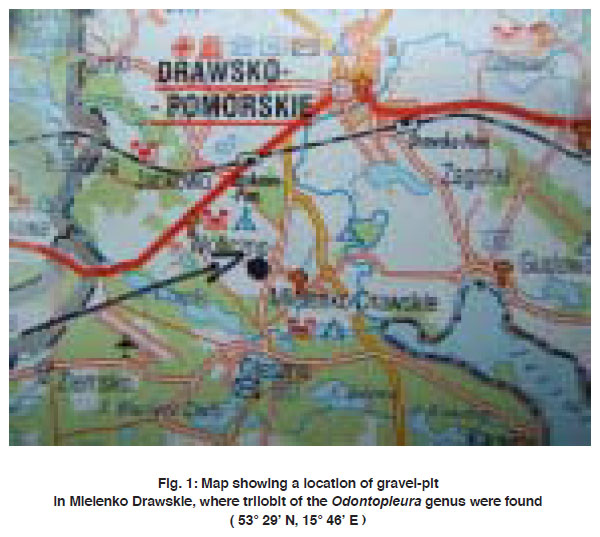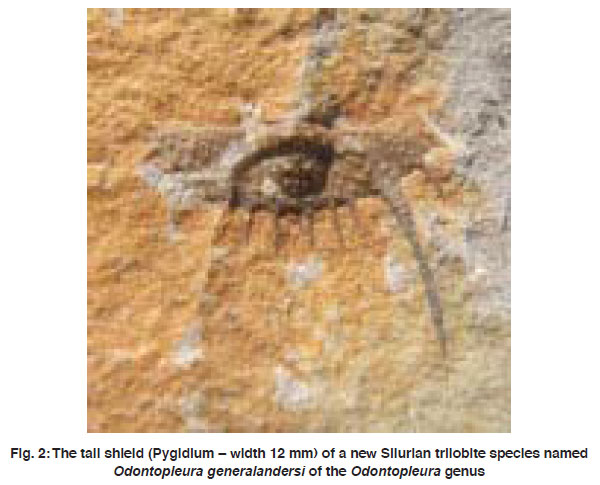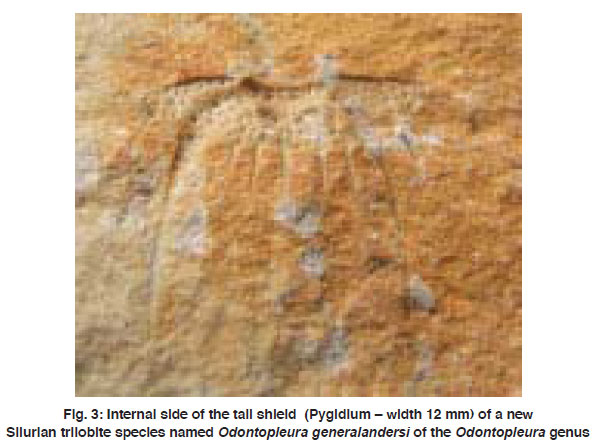Odontopleura generalandersi – a new Silurian trilobite species of the Odontopleura genus occurring in the north Poland
Tomasz Borowski1 *
1
College Complex named under Gen. W. Anders,
Technial School of Environment Protection, 9 Okrzei Street,
Zlocieniec,
78-520
Poland
DOI: http://dx.doi.org/10.12944/CWE.3.2.01
Until now, only one representative of the trilobite Odontopleura ovata Emmrich, 1839, belonging to the Odontopleura Emmrich, 1839 genus and classified into the Odontopleuridae Burmeister, 1843 family, has been known. The paper presents a new Silurian trilobite species classified into the Odontopleura genus. Trilobites of the Odontopleurida Whittington, 1959 order lived within a time period from the Middle Cambrian to the Upper Devonian. At present, their fossilised remnants can be found on every continent.
Copy the following to cite this article:
Borowski T. Odontopleura generalandersi - a new Silurian trilobite species of the Odontopleura genus occurring in the north Poland. Curr World Environ 2008;3(2):213-216 DOI:http://dx.doi.org/10.12944/CWE.3.2.01
Copy the following to cite this URL:
Borowski T. Odontopleura generalandersi - a new Silurian trilobite species of the Odontopleura genus occurring in the north Poland. Curr World Environ 2008;3(2):213-216. Available from: http://www.cwejournal.org/?p=819
Download article (pdf) Citation Manager Publish History
Select type of program for download
| Endnote EndNote format (Mac & Win) | |
| Reference Manager Ris format (Win only) | |
| Procite Ris format (Win only) | |
| Medlars Format | |
| RefWorks Format RefWorks format (Mac & Win) | |
| BibTex Format BibTex format (Mac & Win) |
Article Publishing History
| Received: | 2008-09-09 |
|---|---|
| Accepted: | 2008-10-13 |
Introduction
Silurian deposits in Poland have been long known from natural surface exposures occurring in the Swietokrzyskie Mountains and the Sudeten (H. Tomczyk, 1962a, b, 1970). They have been also reached in very numerous boreholes made on the territory of almost whole Poland, in particular on the eastern European platfrom in the Baltic Depression, the Podlasie Depression and in the Radom-Lublin region.
In Pomerania (north and north-western Poland), Scandinavian postglacial deposits are found on the surface as Quaternary deposits. In these Quaternary deposits, it is possible to find fossils from the Cambrian to the Quaternary. Good locations for searching for fossils are opencast mines. Such a place is for example the Gravel Pit in Mielenek Drawski near Drawsko Pomorskie in the Central Pomerania.
Systematic Paleontology
Class Trilobita Walch, 1771
Order Odontopleurida Wittington, 1959
Family Odontopleuridae Burmeister, 1843
Subfamily Odontopleurinae Burmeister, 1843
Genus Odontopleura Emmrich, 1839
Species Odontopleura Ovata, Emmrich, 1839
Species Odontopleura Generalandersi
New Combination
 |
Figure 1: Map showing a location of gravel-pit in Mielenko Drawskie, where trilobit of the Odontopleura genus were found (53° 29’ N, 15° 46’ E) Click here to view figure |
Locality
The whole Western Pomerania is covered with the mantle of deposits left by the Scandinavian ice-sheet. This mantle, if one can call the upper surface of the whole region this way, is thick, being sometimes tens or even hundreds meters in thickness. The layer of beds, which were left here by the glacier, is thick thus and this makes reaching the older deposits, remembering earlier geological epochs, impossible or badly difficult. In principle, older formations do not emerge on the surface. All, what can be seen here, is a moraine which covers the whole Western Pomerania with a uniform mantle. Thus, it is correct to state that the glacier formed the landscape of Western Pomerania. The glacier, which came several times to the territory of Poland, stretched far away to the south, sometimes as far as to the Carpathian Mountains.
 |
Figure 2: The tail shield (Pygidium – width 12 mm) of a new Silurian trilobite species named Odontopleura generalandersi of the Odontopleura genus Click here to view figure |
The Western Pomerania was always covered with it. Coming down from the Scandinavia, it carried not only huge masses of ice but first of all the stone rubble, which then deposited on our land. This stone rubble is just the Western Pomerania. The process of glacier melting was not uniform. In some places, the glacier stopped moving and stagnated for a longer time. Climatic conditions were like that. The climate cooling induced a stop in ice mass moving and their slower melting. These different situations affected the surface formation. In the places, where more or less flat terrains are found at present, the glacier melting was unhindered, being regular and systematic, and this way a ground moraine developed.
 |
Figure 3: Internal side of the tail shield (Pygidium – width 12 mm) of a new Silurian trilobite species named Odontopleura generalandersi of the Odontopleura genus Click here to view figure |
On the other hand, in the places where there were obstacles in the melting regularity, e.g. due to climate cooling, the glacier stopped there and melted away slower, with stone rubble hillocks developing at its front, or the so called frontal moraines. The process presented above repeated many times. The glacier, advancing again, destroyed the hillocks developed previously, evening them and forming new ones. But finally, after retreating of the last glacier, such a topographic configuration remained in the broad outline as can be observed at present. Thus, the glacier raised a belt of hillocks that stretches out throughout the middle part of Western Pomerania.
In the following Figure 1 a map is presented, in which a location of gravel-pit in the locality of Mielenko Drawskie is showed, 2.5 kilometres away to the south from the district town of Drawsko Pomorskie.
Description of New Species
The tail shield (Pygidium) of Odontopleura generalandersi (new species) is broad and short, just as that of Odontopleura ovata Emmrich, 1839, with the axis having 2 rings and 1 pair of cylindroid ribs directed caudolaterally, changing into main spines. On the edge of the tail shield, between two main spines, there are 5 smaller spines and this is a distinctive feature of a new species named Odontopleura generalandersi. For comparison, the species Odontopleura ovata Emmrich, 1839, has only 4 spines between two main spines on the edge of the tail shield.
On the lateral edges of the tail shield, towards the front from main spines, there are 3 pairs of smaller spines, like in Odontopleura ovata Emmrich, 1839.
On the whole tail shield, numerous tiny papillae are found. (Figs. 2,3).
References
- Adrian, J.M. & Chatterton, B.D.E., Odontopleura (Trilobita, Silurian), and a method of constrained congruency analysis. Journal of Paleontology (1990) 64: 600-614.
- Bruton, D.L., Silurian odontopleurid trilobites from Sweden, Estonia, and Latvia. Palaeontology (1967) 10: 214-244.
- Emmrich, H.F., De Trilobites. Dissertatio petrefactologica etc. Berolini, Berlin. (1839) 56.
- Jeppsson, L. & Calner, M., The Silurian Mulde Event and a scenario for secundosecundo events. Transactions of the Royal Society of Edinburgh: Earth Sciences (2003) 93: 135–154.
- Jeppsson, L., Aldrige, R.J. & Dorning, K.J., Wenlock (Silurian) oceanic episodes and events. Journal of the Geological Society of London (1995)152: 487-498.
- Ramskold, L., Silurian odontopleurid trilobites from Gotland. Palaeontology (1984) 27: 239-264.
- Schrank, E., Odontopleuriden (Trilobita) aus silurischen Geschieben. Berichte der deutschen Gesellschaft für Geologische Wissenschaften, Reihe A, Geologie und Paläontologie (1969) 14: 705-726.
- Siveter, D.J., Silurian trilobites from the Annascaul inlier, Dingle Peninsula, Ireland. Palaeontology (1989) 32: 109-161.
- Snajdr, M., On the genus Odontopleura Emmrich, 1839 (Trilobita). Vûstník Ústfiedního ústavu geologického. (1984) 59, 95–104.







